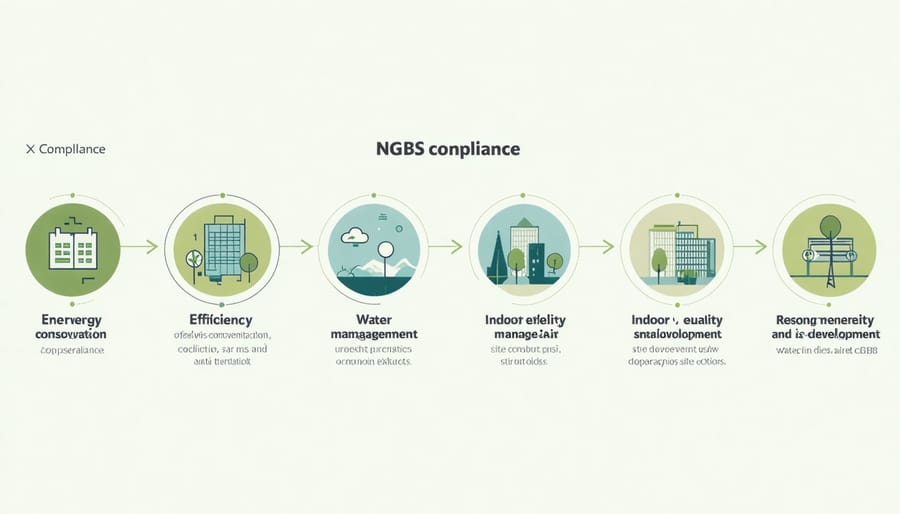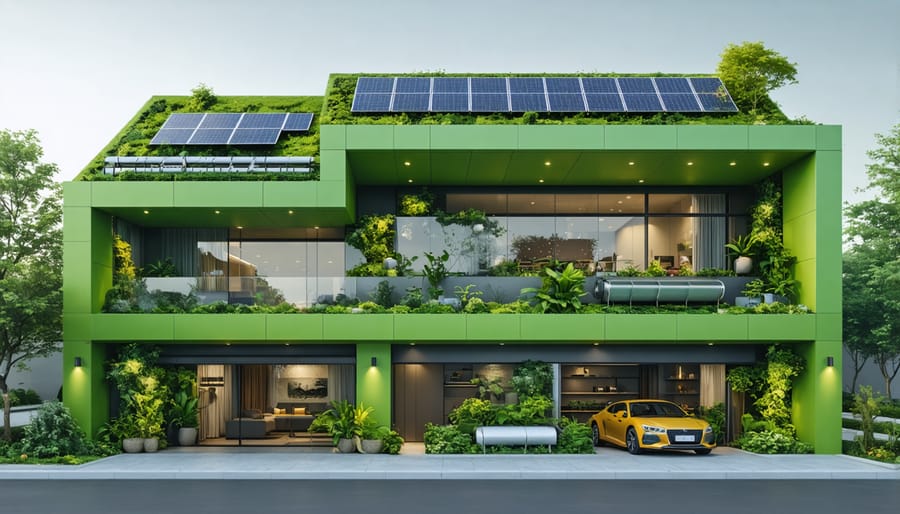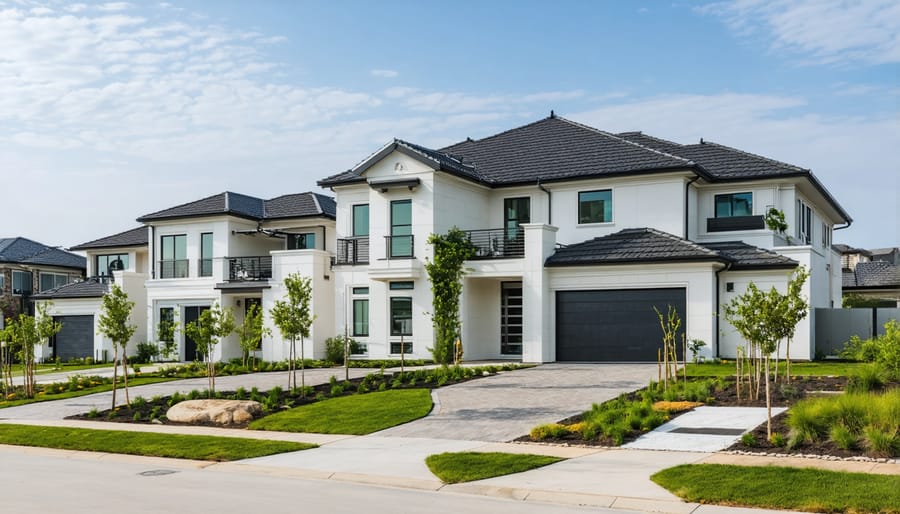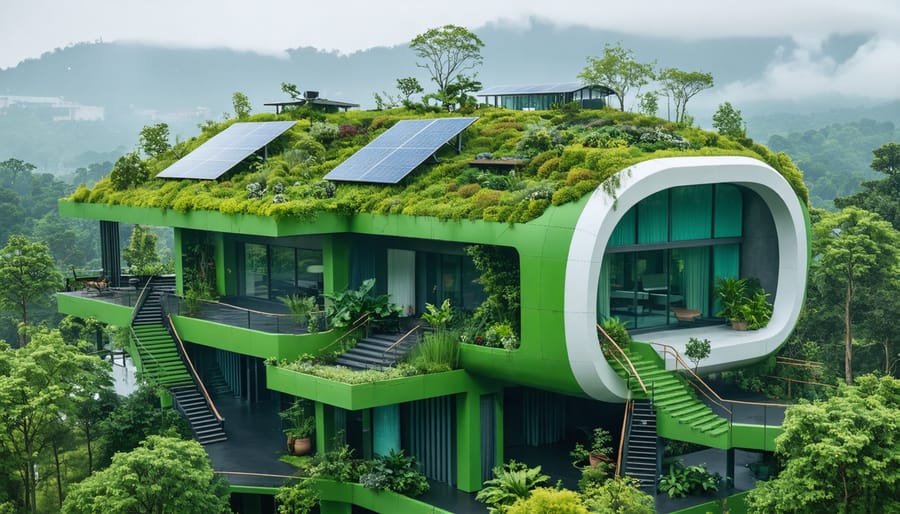National green building standards have revolutionized sustainable construction practices, driving a 500% increase in certified sustainable projects over the past decade. As the cornerstone of modern sustainable development, these standards integrate rigorous environmental performance metrics with practical building solutions that deliver measurable returns on investment. The National Green Building Standard (NGBS) and related green building certifications provide construction professionals with clear, actionable frameworks for achieving environmental excellence while maintaining project profitability.
Industry leaders implementing these standards consistently report 30-40% reductions in energy consumption, 30-50% water savings, and significant improvements in occupant health outcomes. For construction professionals and developers, mastering these standards has become essential for maintaining competitive advantage in an increasingly sustainability-focused market. This comprehensive guide examines the technical requirements, certification processes, and proven strategies for successful NGBS implementation, drawing from extensive case studies and expert insights across the building sector.
Understanding the National Green Building Standard (NGBS)
History and Development
The National Green Building Standard (NGBS) emerged in 2008 as a collaborative effort between the International Code Council (ICC) and the National Association of Home Builders (NAHB). This groundbreaking initiative marked the first residential green building standard to receive approval from the American National Standards Institute (ANSI), establishing its credibility within the construction industry.
The standard underwent significant revisions in 2012, 2015, and 2020, each iteration incorporating advanced sustainability practices and responding to evolving industry needs. The 2020 update notably expanded the scope to include mixed-use buildings and introduced enhanced requirements for energy efficiency and indoor air quality.
Since its inception, NGBS has certified over 250,000 homes and multifamily units, demonstrating its widespread adoption across the United States. The standard’s development process involves rigorous public review and input from diverse stakeholders, including builders, architects, product manufacturers, and environmental advocates. This inclusive approach has helped establish NGBS as a comprehensive and practical framework for sustainable residential construction, balancing environmental stewardship with market feasibility.
Core Components and Requirements
The National Green Building Standard (NGBS) framework is built upon six fundamental pillars that collectively establish a comprehensive approach to sustainable construction. At its core, Lot Design and Development focuses on site selection, preservation of natural resources, and erosion control measures. This component ensures projects minimize their environmental impact from the outset while maximizing site potential.
Resource Efficiency encompasses material selection and waste management, promoting the use of recycled and locally sourced materials while emphasizing strategies for reducing building emissions throughout the construction process. The Energy Efficiency component establishes stringent requirements for building envelope performance, HVAC systems, and lighting solutions, targeting optimal energy consumption and operational cost reduction.
Water Conservation requirements address both indoor and outdoor water usage, incorporating specifications for efficient fixtures, smart irrigation systems, and water recycling solutions. The Indoor Environmental Quality component focuses on ventilation, air filtration, moisture control, and the use of low-emission materials to create healthier living spaces.
Operation, Maintenance, and Building Owner Education represents the final pillar, ensuring long-term sustainability through proper building management and occupant awareness. This component includes detailed documentation requirements, maintenance schedules, and educational materials for building operators and occupants.
Each component is scored on a points-based system, with mandatory minimum requirements and additional optional measures allowing projects to achieve higher certification levels. These components work in concert to deliver buildings that are not only environmentally responsible but also economically viable and occupant-friendly.

Implementation and Certification Process
Project Registration and Documentation
The project registration process begins with submitting a comprehensive application package to an accredited verification body. This package must include detailed architectural plans, specifications, and a preliminary scoring worksheet demonstrating anticipated compliance with NGBS requirements. Project teams need to compile documentation for each claimed practice, including manufacturer data sheets, material specifications, and construction details.
Key documentation requirements include energy modeling reports, water efficiency calculations, site plans highlighting sustainable features, and waste management protocols. Teams must also maintain thorough records of material sourcing, including certificates for sustainable wood products and documentation of recycled content percentages.
For larger developments, phased registration may be appropriate, with each phase requiring separate documentation. Project teams should establish a robust documentation management system early in the process to track submissions and maintain version control. Regular coordination with the designated NGBS verifier ensures documentation aligns with certification requirements and helps identify potential compliance gaps before they become issues.
Time-sensitive documentation, such as construction waste tracking and indoor air quality testing results, must be collected and organized throughout the construction process to avoid delays in final certification.
Verification and Assessment
National green building standards rely on rigorous third-party verification processes to ensure compliance and maintain credibility. Accredited verifiers conduct multiple on-site inspections throughout the construction process, examining everything from material documentation to installation practices. These professionals use standardized checklists and documentation protocols to evaluate projects against established criteria.
The assessment system typically operates on a points-based framework, with projects earning scores across various categories including site development, resource efficiency, energy performance, water conservation, and indoor environmental quality. Projects must achieve minimum point thresholds in each category while accumulating sufficient total points to achieve certification.
Verification typically occurs in three phases: pre-construction document review, construction phase inspections, and final performance testing. Advanced diagnostic tools, such as blower door tests and infrared imaging, are often employed to verify building envelope performance and energy efficiency measures. Upon successful completion, projects receive certification at different levels – Bronze, Silver, Gold, or Emerald – based on their total point achievement and compliance with mandatory provisions.

Certification Levels
The National Green Building Standard (NGBS) certification program offers four distinct levels of achievement, each representing increasingly rigorous sustainability requirements. The Bronze level serves as the entry point, establishing fundamental green building practices while maintaining cost-effectiveness for builders. Projects must achieve mandatory minimums across all categories and score at least 231 points overall.
Silver certification demands more sophisticated sustainable practices, requiring a minimum of 349 points. This tier introduces advanced energy efficiency measures and enhanced resource conservation strategies, appealing to developers seeking to differentiate their projects in competitive markets.
Gold certification represents excellence in sustainable construction, with projects needing to accumulate at least 509 points. At this level, buildings must demonstrate superior performance in areas such as water efficiency, indoor environmental quality, and site design.
The Emerald level represents the pinnacle of green building achievement, requiring a minimum of 697 points. Projects achieving this prestigious certification implement cutting-edge sustainability practices, often incorporating innovative technologies and design solutions that significantly exceed standard building codes and environmental regulations.
Business Benefits and Market Impact
Cost-Effectiveness and ROI
Studies consistently demonstrate that implementing national green building standards delivers substantial returns on investment despite initial cost premiums. Analysis of certified projects shows that green buildings typically command 7-10% higher property values and generate 3.5-7% higher rental rates compared to conventional structures.
The cost premium for achieving certification has decreased significantly, now averaging just 2-4% above traditional construction costs. This investment is typically recovered within 3-5 years through reduced operational expenses, particularly in energy and water consumption. Buildings adhering to national green standards report average energy savings of 25-30% and water savings of 30-40% annually.
Projects can further optimize their ROI by leveraging available renewable energy incentives and tax benefits. Many jurisdictions offer expedited permitting, density bonuses, and reduced fees for certified green buildings, enhancing the financial advantages.
Recent case studies indicate that green-certified buildings experience 14% lower operational costs and 7% higher occupancy rates. Additionally, these properties demonstrate enhanced durability and reduced maintenance requirements, extending the lifecycle value of the investment while minimizing long-term capital expenditures.
Market Differentiation
Adopting national green building standards offers significant market differentiation opportunities for construction companies and developers. Properties certified under these standards typically command premium pricing, with studies showing a 7-10% increase in property values compared to conventional buildings. This price advantage stems from growing market demand for sustainable properties and their demonstrated operational cost savings.
Beyond financial benefits, green-certified buildings attract environmentally conscious tenants and buyers, leading to higher occupancy rates and faster sales cycles. Corporate tenants increasingly prioritize green-certified spaces to meet their environmental, social, and governance (ESG) commitments, creating a competitive advantage for certified properties in the commercial sector.
The certification also serves as a quality assurance marker, distinguishing properties in crowded markets. Buildings meeting national green standards often feature superior indoor air quality, enhanced durability, and better resource efficiency, attributes that resonate strongly with today’s market demands. Furthermore, these certifications provide third-party validation of environmental claims, building trust with stakeholders and strengthening brand reputation.
Early adopters of these standards have reported increased market share and enhanced brand positioning, particularly in regions with strong environmental awareness. This market differentiation becomes increasingly valuable as sustainability continues to drive purchasing decisions across the real estate sector.
Case Studies and Industry Success Stories
Residential Projects
The implementation of National Green Building Standards in residential projects has demonstrated remarkable sustainable construction success across diverse housing developments. Notable examples include The Parkview Residences in Portland, Oregon, a 120-unit multifamily complex that achieved NGBS Gold certification through innovative water management systems and energy-efficient building envelope design, resulting in 40% reduced energy consumption compared to conventional buildings.
In the single-family sector, the Meadowbrook Community in Austin, Texas, stands out with its collection of 85 NGBS-certified homes. These residences incorporate advanced insulation techniques, smart home technology, and solar-ready infrastructure, leading to an average energy cost reduction of 35% for homeowners.
The Vista Gardens development in Denver, Colorado, exemplifies how NGBS certification can be achieved in affordable housing. This 200-unit mixed-income project utilized sustainable materials, efficient HVAC systems, and drought-resistant landscaping to meet Silver certification requirements while maintaining cost-effectiveness.
These projects demonstrate that NGBS certification is achievable across various residential scales and price points. Key success factors include early integration of green building strategies in the design phase, careful material selection, and comprehensive construction team training. The resulting developments not only meet certification requirements but also deliver tangible benefits in terms of reduced operating costs, improved indoor air quality, and enhanced market value.

Commercial Developments
Commercial green building implementations have shown significant growth, with LEED-certified commercial spaces now exceeding 100 billion square feet globally. Major corporations and developers increasingly adopt national green building standards, driven by both environmental responsibility and economic benefits. Studies indicate that green-certified commercial buildings command 7-10% higher rental rates and maintain 15-20% lower operating costs compared to conventional structures.
Notable implementations include the Bank of America Tower in New York, which achieved LEED Platinum certification through innovative features like waterless urinals, gray water recycling, and advanced air filtration systems. The building demonstrates how green standards can be successfully applied to large-scale commercial projects while maintaining premium office space requirements.
Recent data shows that green-certified commercial buildings experience 3.5% higher occupancy rates and 13% higher asset values. Developers report increased tenant satisfaction and reduced maintenance costs, particularly in HVAC and lighting systems. The implementation of smart building technologies, combined with green building standards, has created a new benchmark for commercial development.
Insurance companies and financial institutions now offer preferential rates for green-certified commercial properties, recognizing their reduced operational risks and enhanced long-term value. This financial incentive has accelerated the adoption of national green building standards across the commercial sector, particularly in urban development projects and corporate campuses.
The National Green Building Standard continues to shape the future of sustainable construction, serving as a cornerstone for environmentally responsible development across the United States. As the industry evolves, NGBS certification has become increasingly vital for projects seeking to meet both environmental goals and market demands. The standard’s comprehensive approach to sustainability, covering everything from resource efficiency to indoor environmental quality, positions it as an essential framework for the future of green building.
Looking ahead, the construction industry can expect NGBS to adapt to emerging technologies and environmental challenges. The standard’s regular updates ensure it remains relevant and effective in addressing climate change, resource conservation, and occupant health concerns. Industry professionals who embrace NGBS certification gain a competitive advantage while contributing to a more sustainable built environment.
The growing adoption of NGBS certification reflects a broader shift toward sustainable construction practices. As market demand for green buildings continues to rise, NGBS-certified projects demonstrate superior performance in energy efficiency, water conservation, and overall environmental impact. This trend is likely to accelerate as environmental regulations tighten and stakeholders increasingly prioritize sustainability.
For construction professionals, maintaining expertise in NGBS requirements and certification processes will be crucial for future success. The standard’s influence on project specifications, building codes, and industry best practices will only grow stronger, making it an indispensable tool for those committed to sustainable development.

